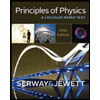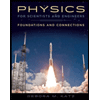In a game of football outdoors on a cold day, a player will begin to feel exhausted after using approximately 8.0 × 105 J of internal energy. (a) One player, dressed too lightly for the weather, has to leave the game after losing 6.6 × 105 J of heat. How much work has he done? (b) Another player, wearing clothes that offer better protection against heat loss, is able to remain in the game long enough to do 2.9 × 105 J of work. What is the magnitude of the heat that he has lost? (a) number units (b) number units
In a game of football outdoors on a cold day, a player will begin to feel exhausted after using approximately 8.0 × 105 J of internal energy. (a) One player, dressed too lightly for the weather, has to leave the game after losing 6.6 × 105 J of heat. How much work has he done? (b) Another player, wearing clothes that offer better protection against heat loss, is able to remain in the game long enough to do 2.9 × 105 J of work. What is the magnitude of the heat that he has lost? (a) number units (b) number units
College Physics
11th Edition
ISBN:9781305952300
Author:Raymond A. Serway, Chris Vuille
Publisher:Raymond A. Serway, Chris Vuille
Chapter12: The Laws Of Thermodynamics
Section: Chapter Questions
Problem 67AP
Related questions
Question
In a game of football outdoors on a cold day, a player will begin to feel exhausted after using approximately 8.0 × 105 J of internal energy. (a) One player, dressed too lightly for the weather, has to leave the game after losing 6.6 × 105 J of heat. How much work has he done? (b) Another player, wearing clothes that offer better protection against heat loss, is able to remain in the game long enough to do 2.9 × 105 J of work. What is the magnitude of the heat that he has lost?
(a) number units
(b) number units
Expert Solution
This question has been solved!
Explore an expertly crafted, step-by-step solution for a thorough understanding of key concepts.
This is a popular solution!
Trending now
This is a popular solution!
Step by step
Solved in 2 steps with 2 images

Knowledge Booster
Learn more about
Need a deep-dive on the concept behind this application? Look no further. Learn more about this topic, physics and related others by exploring similar questions and additional content below.Recommended textbooks for you

College Physics
Physics
ISBN:
9781305952300
Author:
Raymond A. Serway, Chris Vuille
Publisher:
Cengage Learning

Principles of Physics: A Calculus-Based Text
Physics
ISBN:
9781133104261
Author:
Raymond A. Serway, John W. Jewett
Publisher:
Cengage Learning

Physics for Scientists and Engineers: Foundations…
Physics
ISBN:
9781133939146
Author:
Katz, Debora M.
Publisher:
Cengage Learning

College Physics
Physics
ISBN:
9781305952300
Author:
Raymond A. Serway, Chris Vuille
Publisher:
Cengage Learning

Principles of Physics: A Calculus-Based Text
Physics
ISBN:
9781133104261
Author:
Raymond A. Serway, John W. Jewett
Publisher:
Cengage Learning

Physics for Scientists and Engineers: Foundations…
Physics
ISBN:
9781133939146
Author:
Katz, Debora M.
Publisher:
Cengage Learning

Physics for Scientists and Engineers, Technology …
Physics
ISBN:
9781305116399
Author:
Raymond A. Serway, John W. Jewett
Publisher:
Cengage Learning